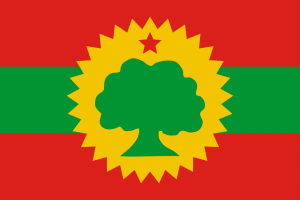Language/Borana-arsi-guji-oromo/Grammar/Basic-Sentence-Structure
| ◀️ Alphabet and Pronunciation — Previous Lesson | Next Lesson — Common Greetings ▶️ |
Introduction[edit | edit source]
Welcome to the lesson on the basic sentence structure of the Borana-Arsi-Guji Oromo language! In this lesson, we will explore the fundamental elements of forming sentences in Borana-Arsi-Guji Oromo. Understanding the basic sentence structure is crucial for effective communication in any language, and it serves as the foundation for further language learning. By the end of this lesson, you will be able to construct simple sentences in Borana-Arsi-Guji Oromo with ease.
Subject, Verb, and Object Order[edit | edit source]
In Borana-Arsi-Guji Oromo, the basic sentence structure follows the subject-verb-object (SVO) order. This means that the subject of the sentence comes first, followed by the verb, and then the object. Let's break down each component and examine their roles in the sentence.
Subject[edit | edit source]
The subject of a sentence is the person, thing, or idea that performs the action or is being described. In Borana-Arsi-Guji Oromo, the subject is often placed at the beginning of the sentence to indicate who or what is performing the action. Here are a few examples:
- "Qajeen isin" (The cat is sleeping)
- "Obbo Ali dhufan" (Mr. Ali is running)
In the first example, "Qajeen" (cat) is the subject of the sentence, and "isin" (is sleeping) is the verb. In the second example, "Obbo Ali" (Mr. Ali) is the subject, and "dhufan" (is running) is the verb.
Verb[edit | edit source]
The verb is the action or state of being in a sentence. It expresses what the subject is doing or experiencing. In Borana-Arsi-Guji Oromo, verbs typically come after the subject and before the object. Here are a few examples:
- "Abbaa dhufan" (Father is running)
- "Anaaba lama" (I am singing)
In the first example, "dhufan" (is running) is the verb that describes the action of the subject "Abbaa" (father). In the second example, "lama" (am singing) is the verb that indicates the action of the subject "Anaaba" (I).
Object[edit | edit source]
The object is the person or thing that receives the action of the verb in a sentence. It answers the question "who?" or "what?" the action is being done to. In Borana-Arsi-Guji Oromo, the object typically comes after the verb. Here are a few examples:
- "Obbo Ali fiqiran" (Mr. Ali is reading a book)
- "Aniisaa dogon" (Anisa is eating food)
In the first example, "fiqiran" (a book) is the object that receives the action of the verb "fiqir" (is reading). In the second example, "dogon" (food) is the object that receives the action of the verb "doga" (is eating).
Cultural Insights[edit | edit source]
The Borana-Arsi-Guji Oromo people have a rich cultural heritage, and their language reflects their unique traditions and way of life. The Oromo people, also known as the Oromos, are the largest ethnic group in Ethiopia and are widely dispersed throughout the country. The Borana, Arsi, and Guji are three subgroups of the Oromo people, each with their distinct dialects and cultural practices.
In the Borana-Arsi-Guji Oromo culture, oral tradition plays a significant role in preserving their history and passing down knowledge from one generation to another. Storytelling, proverbs, and poetry are highly valued forms of communication among the Oromo people. It is through these oral traditions that the Borana-Arsi-Guji Oromo language has been preserved and continues to thrive.
Exercises[edit | edit source]
Now it's time to practice what you've learned! Try constructing sentences using the basic sentence structure of Borana-Arsi-Guji Oromo. Use the provided vocabulary and examples to guide you. Once you're done, check the solutions below.
Exercise 1[edit | edit source]
Construct sentences using the following subject-verb-object structure:
- Subject: Qajeen (cat)
- Verb: isin (is sleeping)
- Object: qubee (bed)
Solutions:
- Qajeen isin qubee. (The cat is sleeping on the bed.)
Exercise 2[edit | edit source]
Construct sentences using the following subject-verb-object structure:
- Subject: Obbo Ali (Mr. Ali)
- Verb: dhufan (is running)
- Object: gadaa (field)
Solutions:
- Obbo Ali dhufan gadaa. (Mr. Ali is running in the field.)
Exercise 3[edit | edit source]
Construct sentences using the following subject-verb-object structure:
- Subject: Anaaba (I)
- Verb: lama (am singing)
- Object: jaalala (love)
Solutions:
- Anaaba lama jaalala. (I am singing about love.)
Conclusion[edit | edit source]
Congratulations on completing the lesson on the basic sentence structure of the Borana-Arsi-Guji Oromo language! You now have a solid understanding of how to form sentences using the subject-verb-object order. Keep practicing and applying what you've learned in real-life conversations to enhance your language skills. In the next lesson, we will explore another important aspect of the Borana-Arsi-Guji Oromo language. So stay tuned!
Other Lessons[edit | edit source]
- Negation
- Present Tense
- Singular and Plural Nouns
- Give your Opinion
- Past Tense
- Questions
- Conditional Mood
- Personal Pronouns
- Pronouns
Template:Borana-arsi-guji-oromo-Page-Bottom
| ◀️ Alphabet and Pronunciation — Previous Lesson | Next Lesson — Common Greetings ▶️ |

